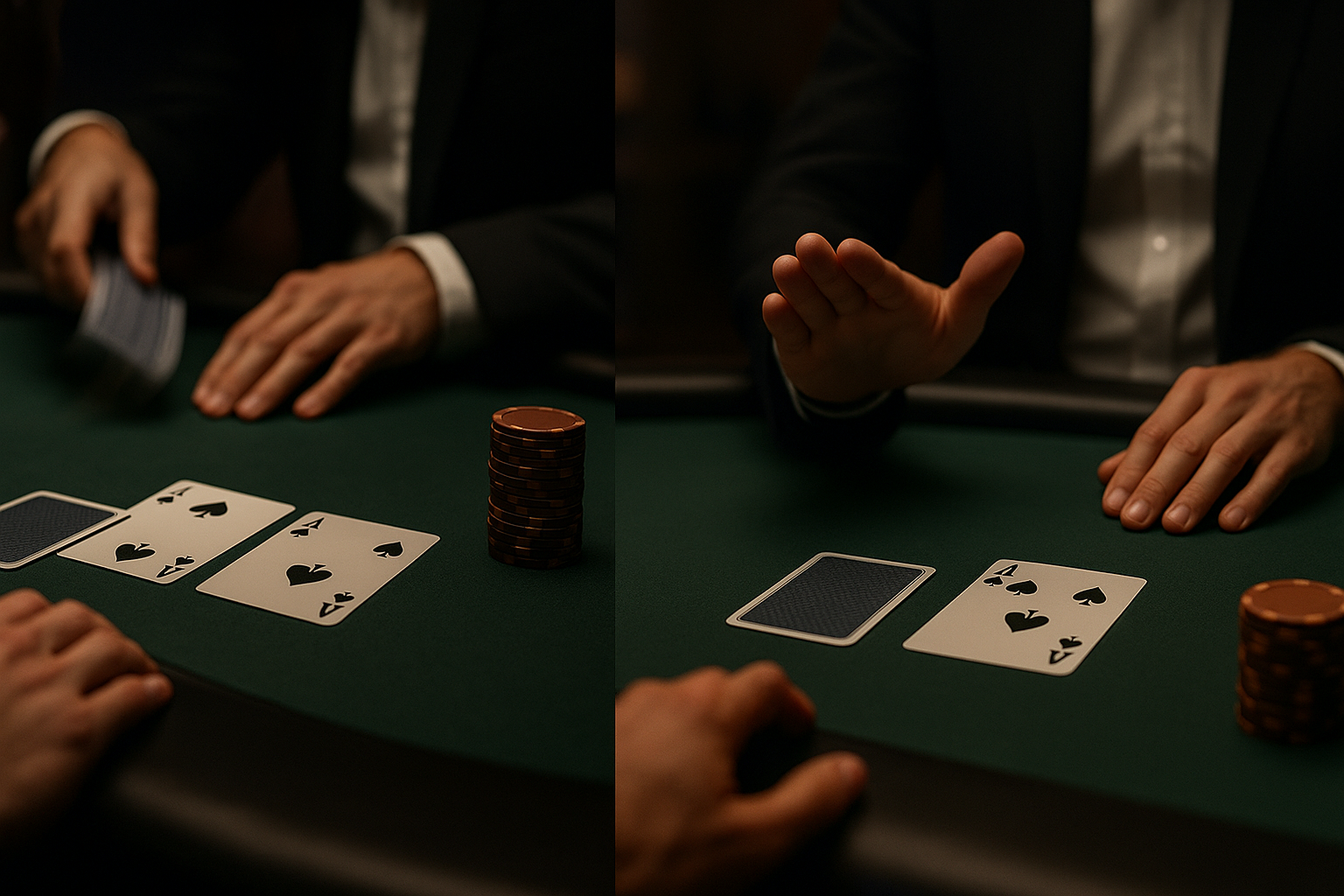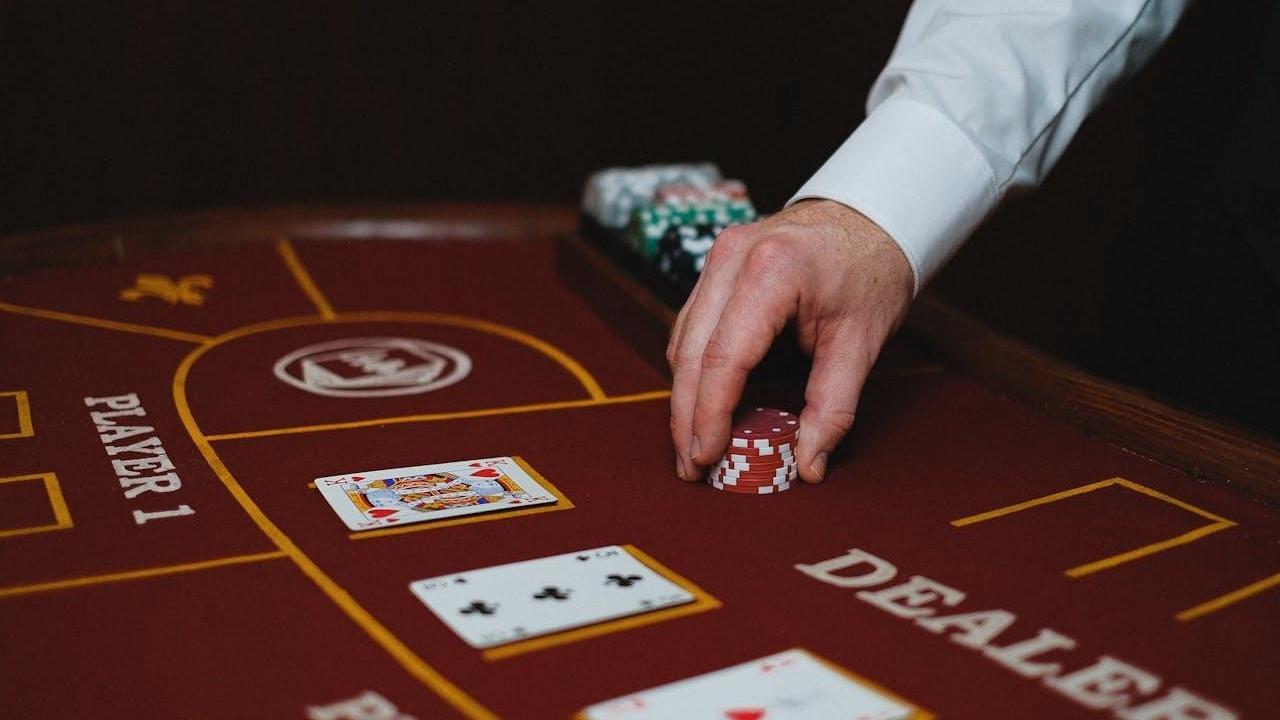Blackjack dealer handling chips - source
When you sit down at a blackjack table, the chips and felt may look the same, but the rules written on that small placard can completely alter how the game feels. Three toggles in particular—H17 vs S17, surrender, and double after split (DAS)—change the rhythm, the choices, and even the tension of every hand. These aren’t abstract math quirks hidden away in strategy charts. They’re practical rule flags that shape how you react when the dealer flips a card or when your split hands start to stack up.
What H17 vs S17 Really Means
The shorthand H17 and S17 refers to whether the dealer hits or stands on a “soft 17” (a hand like Ace–6). On a surface level, it looks minor, but the difference plays out hand after hand. In H17, the dealer has to take another card with Ace–6, which increases volatility. Sometimes it busts the dealer, sometimes it improves their hand. In S17, the dealer holds steady at that total, and players can better predict how the round will end.
The experience is different depending on which version is in play. H17 tends to make the game feel more pressured, especially when you’re already sitting on a 17 or 18. S17 makes outcomes steadier and less nerve-racking. Neither rule is inherently “better,” but it’s important to recognize the table you’re at, because your decision-making will shift along with it.
Why Rule Cards Matter Before You Play
Many players glance at the rule card for table minimums and leave it at that. But knowing how H17 vs S17, surrender, and DAS are handled can stop you from feeling caught off guard mid-hand. Compare two rule cards side-by-side from blackjack games Cafe Casino and tick our three-flag checklist. The rule details when you play blackjack games aren’t fine print—they are the framework that defines how smooth or stressful the game flow will be once cards hit the felt.
In fact, there’s a helpful resource that breaks down H17 vs S17 more directly. This guide explains which version tends to benefit the dealer and why understanding the difference helps shape expectations before you start playing. By linking this back to the other two flags, you can quickly build a picture of what kind of blackjack you’re about to experience.
Surrender: Folding Without Shame
Surrender is often misunderstood. Some players see it as “giving up,” but in practice, it is a tactical retreat. With surrender allowed, you can forfeit half your bet rather than play out a hand you know is stacked against you—like when you hold a hard 16 against a dealer’s 10. Without surrender, you’re forced to hit or stand, both uncomfortable options.

From a player’s perspective, surrender creates a safety valve. It won’t come up every round, but when it does, it changes the mental load. Knowing you can cut losses in specific high-risk scenarios adds a different kind of confidence. The choice is more about reducing damage than chasing wins, which is why players often prefer tables that keep this option open.
Double After Split (DAS): Momentum Builder
Splitting pairs is one of blackjack’s most exciting moments, but the flexibility you’re given afterward makes a big difference. With DAS in play, you can split a pair—say two 8s against a dealer 6—and then double down on one of the resulting hands if the next card gives you a strong total. Without DAS, you’re locked out of that move, and the hand loses some of its potential.
For many players, DAS rules bring more freedom and flow. It means that when the cards start working in your favor, you can push the advantage instead of being forced into a cautious stand. This rule shifts the energy of split hands from defensive to opportunistic, and once you get used to having it, tables without DAS can feel restrictive.
How These Flags Shape Play Feel
Taken together, H17 vs S17, surrender, and DAS are more than isolated toggles. They form the DNA of how blackjack plays out. H17 tilts the table toward unpredictability, S17 brings calm consistency, surrender offers a relief valve, and DAS injects excitement into splits. Players often describe “fast tables” or “tight tables,” but what they’re really feeling is the mix of these three core rule flags.
Understanding them also prevents mid-hand surprises. Nothing sours a night faster than splitting a pair, planning to double, and then hearing the dealer say DAS isn’t allowed. Or hitting a tough 16 only to remember too late that surrender wasn’t an option. By reading the card at the start, you know what you’re stepping into and can adjust expectations before a single bet goes down.
Knowing the Small Details
Blackjack isn’t just about the cards in your hand or strategies like card counting—it’s about the small details on the rule card that shape how the game feels. H17 vs S17 sets the pace, surrender determines whether you have a way out, and DAS defines how much momentum you can ride after a split. None of these rules changes the fun of the game, but they absolutely change your decisions in the moment.




